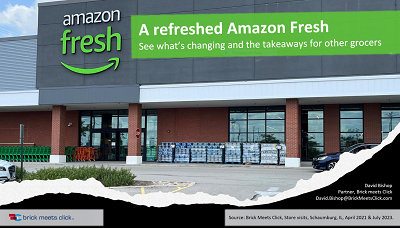Grocers are at a crossroads as Instacart charts its path to the public market
Complete the form below to instantly download this month's dashboard.

The recent Bloomberg LP piece Instacart CEO Courts Investors, Skeptical Grocers Ahead of IPO by Jackie Davalos illustrates the crossroads that both Instacart and many grocery retailers find themselves at today. And, the stakes are high for both parties.
High Stakes for both Instacart and grocery retailers
For Instacart, the path forward hinges on raising additional capital to invest in its updated vision for where it wins going forward. However, given the challenging economic times, it's reasonable to assume that the confidential filing is intended to take the temperature of the investment community.
It's also fair to expect pressure for a lower valuation - even though private investors would prefer that not be the case, as it could end up in a position like DoorDash, Uber, and Lyft, where public investors see little, if any upside to buying into Instacart’s story about its future prospects.
For retailers, online grocery has become essential to market-level growth; however, its higher cost-to-serve model requires greater control to lower costs, and this requires building stronger connections with their customers. If retailers depend largely on Instacart and its marketplace, the problem with following this path is that these customers are not technically the retailer’s to nurture.
While Instacart talks about its retail “partnerships,” the legal constructs mean that retailers can't connect with customers in more meaningful ways, can't customize the service to better align with their business, can't communicate with these customers (even though IC promotes competing offers to these same people), and can't chart a path to improved profitability very well.
And, while some may feel they fare better on Instacart Enterprise, it's not your typical "white label" platform. It has become the carrot that obscures the stick associated with the agreement and Instacart’s marketplace.
Instacart represents a fork in the road, causing retailers to pick a path
Instacart, like Amazon, has some very impressive tech capabilities, so the pivot makes a degree of sense from its perspective. However, convincing most grocers that the pivot is beneficial to them will likely be challenging. Figuratively speaking, Instacart represents the next fork in the road, forcing retailers to choose which path they will take.
It's worth watching the Florida market where Publix Super Markets is likely feeling the impact from Kroger's delivery-only entry , which has surprised many. Some important lessons can be learned here and, depending on how those lessons get socialized across the retail industry, they could also complicate Instacart’s current set of strategies.
Some grocers may have their own reasons to follow Instacart’s lead and direction while others have pivoted to another path. The challenge for current and potential investors is that it’s difficult to sense where and how this is affecting Instacart today.
Part of the reason is that you're unlikely to see any retailer exit or delist from Instacart’s marketplace entirely. Rather, retailers pursuing a different path will revise the role Instacart plays in general, building instead demand on their first-party ordering platforms while leveraging opportunities inherent in the current structure to strengthen their own efforts to improve the profitability of competing online.
What's next?
Only time will tell if Instacart’s path to the public market will be similar to Blue Apron’s, which saw the company dramatically pair back its initial IPO price based on the reception received during its pre-IPO roadshow. The downward pressure on Blue Apron’s valuation was in part due to Amazon's acquisition of Whole Foods Market, which triggered concerns about the competitive environment and its outlook. Even so, that price discount wasn't enough; Blue Apron's stock is now worth <5% of the final IPO price, adjusting for the fact that they did a reverse 1:15 stock split.
That’s Instacart’s issue, but grocers have their own challenges as they attempt to mitigate the cost pressures that come with this mode of shopping and create competitive points of differentiation that will help them grow and strengthen their value proposition.
In simple terms, this will require grocers to better understand who their customers are and why they shop with them, then put that into perspective relative to their competitive position, and figure out how they can win more by leveraging opportunities and strengthening capabilities on their journey to becoming an omnichannel retailer.
Related Posts
> As Kroger's plans for Ocado in FL become visible, key challenges still exist
> April 2022 U.S. Online Grocery: Sales total $8.1 billion, down nearly 4% vs last year
Brick Meets Click is a US grocery analytics &strategic insightfirm that helps organizations make sense out of the changing market. Wedeliver objective, fact-driven guidance on how business is evolving andwhere there are emerging opportunities and/or threats so companies canproactivelyrespond. Learn more about our core services for retailers .












